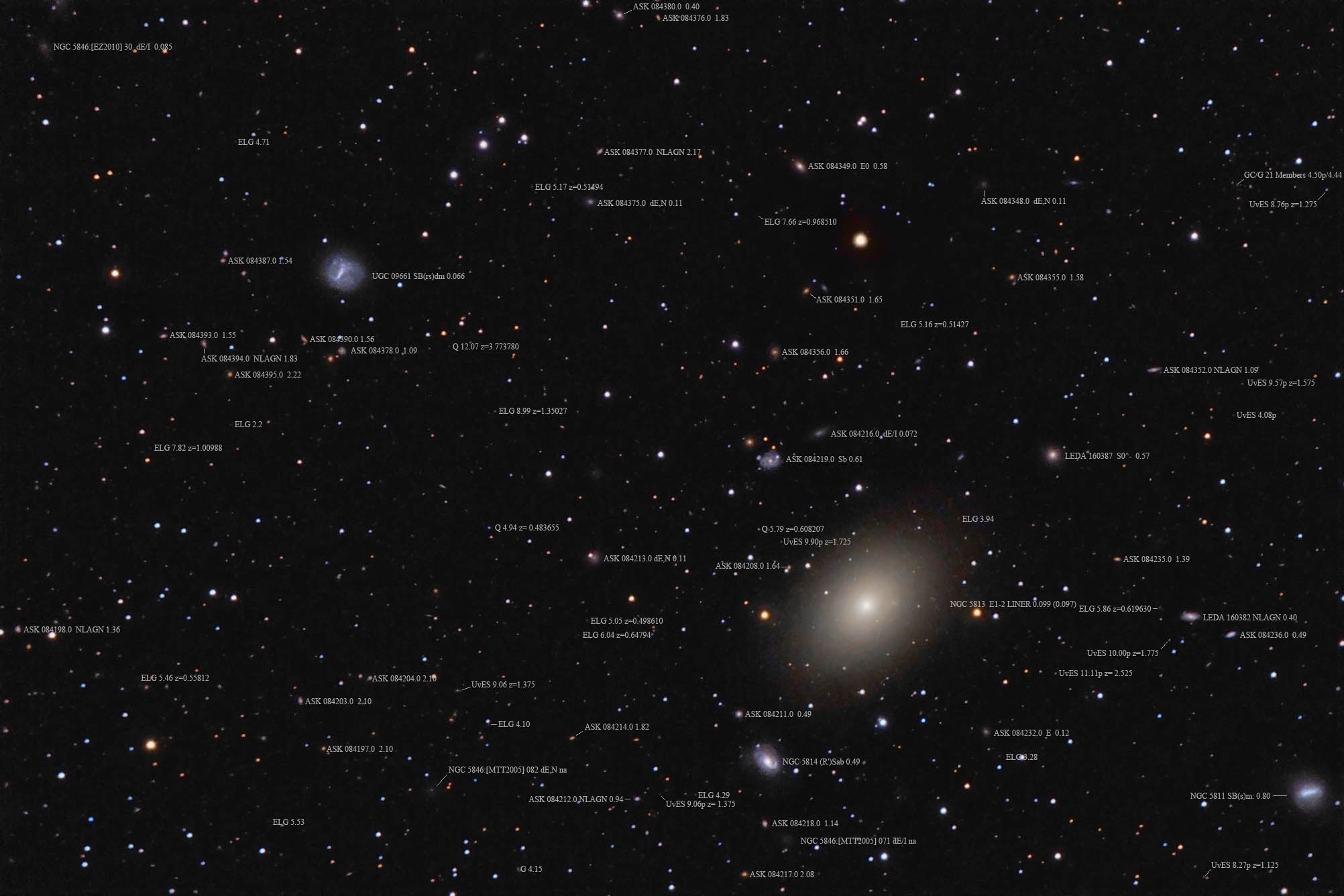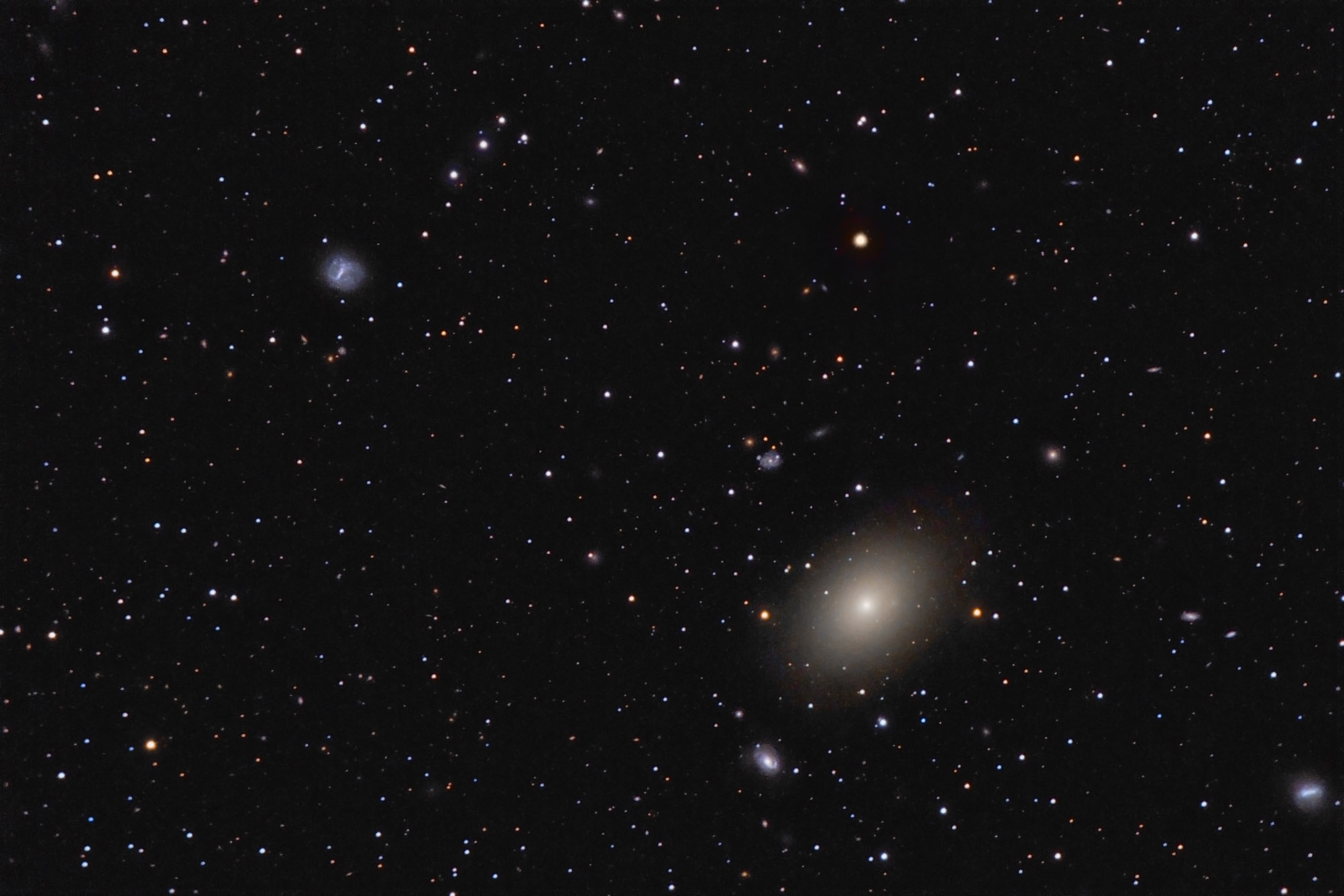| Description | Images |
Object name: NGC5813Designation(s): NGC5813, NGC5811, NGC5814, UGC09661, NGC 5813 is a huge elliptical galaxy in eastern Virgo about 99 million light-years distant by redshift and 97 by the d-sigma method. http://ned.ipac.caltech.edu/level5/Willick/frames.html I measure its size as about 177,000 light-years at the 99 million light-year distance. Since the edges just fade away this is likely smaller than its real size. While I see what look like they could be globular star clusters in the outskirts of the galaxy NED doesn't list any. I can't believe a giant elliptical like this one wouldn't have a lot of them. It seems to have some companions but their distances appear far too close to us for these to be true companions. They are apparently only line of sight galaxies. NED does list some true companions but they are all well out of my field of view. It was discovered by William Herschel on February 24, 1786. It is in the second H400 program. Related Designation(s):1RXS J150111.6+014151, 2MASS J15011123+0142071, 2MASS J15012116+0138133, 2MASS J15020355+0150281, 2MASX J15011126+0142070, 2MASX J15012118+0138134, 2MASX J15020353+0150280, 2XMM J150111.2+014208, 2XMM J150111.4+014204, 2XMM J150121.1+013813, AKARI J1501214+013817, ASK 084215.0, CGCG 020-043, CGCG 020-045, CGCG 020-046, CGCG 020-048, CGCG 1457.9+0148, CGCG 1458.6+0153, CGCG 1458.8+0149, CGCG 1459.5+0201, CXO J150111.19+014206.9, CXO J150121.14+013813.5, GALEX J150111.4+014208, GALEXASC J150111.29+014206.7 , GALEXASC J150121.13+013813.9 , GALEXASC J150203.53+015029.6 , GALEXMSC J150111.39+014208.3 , GALEXMSC J150121.07+013813.5 , GALEXMSC J150203.46+015029.1 , HDCE 0897 NED003, HOLM 688A, HOLM 688B, IRAS 14588+0149, IRAS F14578+0149, IRAS F14588+0150, IRAS F14595+0201, KPG 450, LDCE 1076 NED035, LGG 392:[G93] 002, LGG 392:[G93] 003, LGG 393:[G93] 001, MCG +00-38-015, MCG +00-38-016, MCG +00-38-017, MCG +00-38-018, Mr18:[BFW2006] 02073 NED02, NGC 5811, NGC 5813, NGC 5813:[L2011a] X0002, NGC 5814, NGC 5814:[L2011a] X0001, NGC 5846:[MTT2005] 064, NGC 5846:[MTT2005] 083, NGC5811, NGC5813, NGC5814, NSA 015358, NSA 145756, NSA 165862, NVSS J150110+014206, NVSS J150121+013813, PGC 053597, PGC 053643, PGC 053653, PGC 053683, RBS 1453, RX J1501.1+0141, RX J1501.1+0141:[BEV98] 001, RX J1501.1+0141:[ZEH2003] 01 , RXC J1501.1+0141, RXC J1501.2+0141, SDSS J150111.23+014207.1, SDSS J150121.14+013813.4, SDSS J150121.15+013813.5, SDSS J150203.50+015028.6, SSTSL2 J150111.24+014207.6, SSTSL2 J150121.10+013813.5, UGC 09655, UGC 09661, UGC09661, UNAM-KIAS 1284, USGC U677 NED11, USGC U677 NED12, UZC J150111.2+014207, UZC J150121.1+013813, UZC J150203.5+015029, [AHG2014] B209, [BFW2006] J225.33811+01.63707 , [GMM2009b] 68, [LG2007] 69, [M98j] 238 NED07, [MB2007] J225.2957+01.7019, [PVK2003] J225.33809+01.63706 , [TTL2012] 474999, [VPP2013] 21, [WB92] 1458+0153, |

